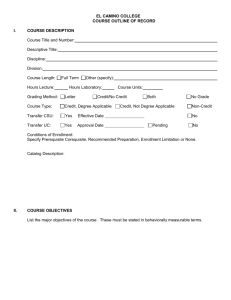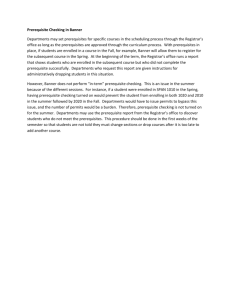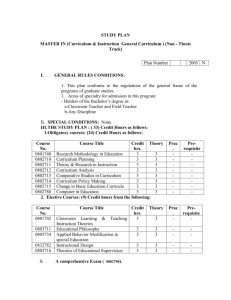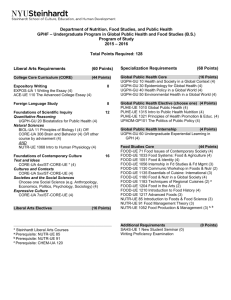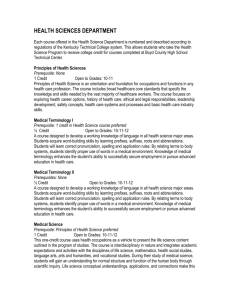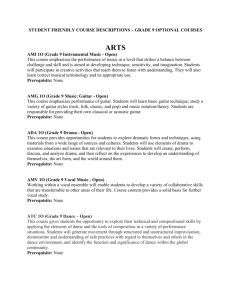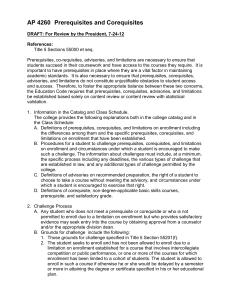Course Outline Writing Guide
advertisement
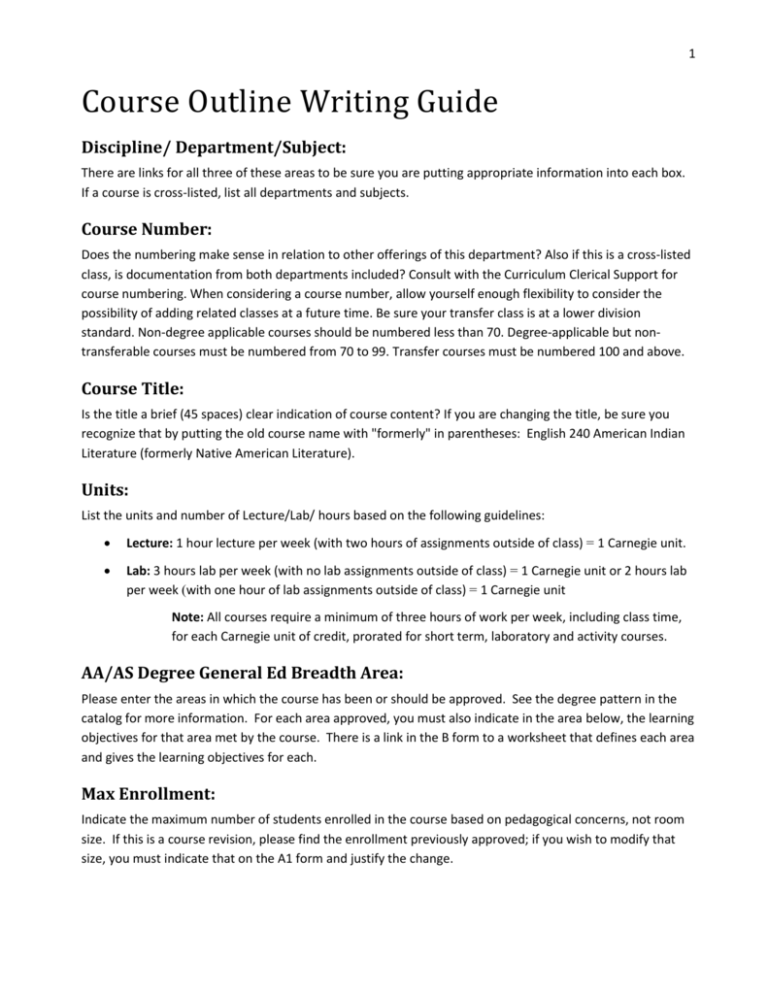
1 Course Outline Writing Guide Discipline/ Department/Subject: There are links for all three of these areas to be sure you are putting appropriate information into each box. If a course is cross-listed, list all departments and subjects. Course Number: Does the numbering make sense in relation to other offerings of this department? Also if this is a cross-listed class, is documentation from both departments included? Consult with the Curriculum Clerical Support for course numbering. When considering a course number, allow yourself enough flexibility to consider the possibility of adding related classes at a future time. Be sure your transfer class is at a lower division standard. Non-degree applicable courses should be numbered less than 70. Degree-applicable but nontransferable courses must be numbered from 70 to 99. Transfer courses must be numbered 100 and above. Course Title: Is the title a brief (45 spaces) clear indication of course content? If you are changing the title, be sure you recognize that by putting the old course name with "formerly" in parentheses: English 240 American Indian Literature (formerly Native American Literature). Units: List the units and number of Lecture/Lab/ hours based on the following guidelines: Lecture: 1 hour lecture per week (with two hours of assignments outside of class) = 1 Carnegie unit. Lab: 3 hours lab per week (with no lab assignments outside of class) = 1 Carnegie unit or 2 hours lab per week (with one hour of lab assignments outside of class) = 1 Carnegie unit Note: All courses require a minimum of three hours of work per week, including class time, for each Carnegie unit of credit, prorated for short term, laboratory and activity courses. AA/AS Degree General Ed Breadth Area: Please enter the areas in which the course has been or should be approved. See the degree pattern in the catalog for more information. For each area approved, you must also indicate in the area below, the learning objectives for that area met by the course. There is a link in the B form to a worksheet that defines each area and gives the learning objectives for each. Max Enrollment: Indicate the maximum number of students enrolled in the course based on pedagogical concerns, not room size. If this is a course revision, please find the enrollment previously approved; if you wish to modify that size, you must indicate that on the A1 form and justify the change. 2 TOP Code: TOP (Taxonomy of Program) codes are used for the purposes of classification on a statewide basis. A link on the B form will help you determine which TOP code best fits your course (if you have questions, contact the Curriculum Chair or the Curriculum Clerical Support). If this is a course revision, please find the TOP code previously approved; if you wish to modify that code, you must indicate that on the A1 form and justify the change. Pass/No Pass only: Most courses allow students to take the course as Pass/No Pass but do not require the course be taken for Pass/No Pass rather than a grade. If the class is graded Pass/No Pass only, mark "Yes"; otherwise, mark "No." Repeatability: Title 5 allows all students to repeat classes for which they receive substandard (nonpassing) grades. This section of the form relates to courses that allow students to repeat the class even if they have taken and passed it previously. Title 5 specifies the types of classes that can be repeated for credit, including lab courses that increase skills or lecture courses that significantly change content from year to year may be repeated. These courses may not be repeated more than four times. Stand Alone: A Stand Alone course is a non-degree applicable credit course or a degree applicable credit course which is not part of a degree or state certificate and is not approved in one of the GE areas. If a course is only approved in an employment concentration certificate, it is considered Stand Alone. If the course is Stand Alone, indicate that in this box as well as in the Stand Alone field on Form A1. Catalog Description: Is the description a concise (75 words or less) and clear indication of course content? Description should be written in complete sentences, in the present tense and should summarize what a successful learner can demonstrate at the end of the course. We no longer include a statement about the students for which the course is intended, so if you are revising an older course outline that incorporates that language, please delete it (examples to delete include “first course in the graphic arts major” or “intended for students in allied health majors” or “meets foreign language requirement”). We also no longer include repeatability information in the catalog description since Datatel will automatically incorporate that information into the catalog. Remember that this description is the main vehicle students use to select classes, counselors use to advise, and upon which outside reviewers base their assessments. Strive for a succinct, accurate but comprehensive summary of the course. Schedule Description: Is the course described in fewer than 120 characters (25 words)? Does it represent a composite of the catalog description? 3 Need/ Justification/ Goals: Is this statement an effective summary of the role of the course in the major program or general educational areas in which it is designed to serve? State the fulfillment of degree, certificate, transfer or other need. Prerequisite/s (Requisites), Corequisite, Recommended Preparation, or other Enrollment Criteria: This requires an additional approval as a separate action. Attach completed Prerequisite Form E1-E5 (depending on type of prerequisite/corequisite/recommended preparation). What are Prerequisites? “Prerequisites are conditions of enrollment that students are required to meet prior to enrollment in particular courses and programs. The assignment of a prerequisite to a course signifies that the courses, skills, or body of knowledge described in the prerequisite are essential to the success of the student in that course and that it is highly unlikely that a student who has not met the prerequisite will receive a satisfactory grade in the course (or at least one course in the program) for which the prerequisite has been established.” Prerequisites, Corequisites, Advisories, and Limitations on Enrollment (Fall 1997), Chancellor’s Office, California Community Colleges, Student services and Special Programs Division The following are justifications for prerequisites/corequisites/recommended preparation: To insure that the students have the skills, concepts, and information necessary to complete the course successfully To insure the health and safety of the students Is it required in comparable courses by four-year institutions? Is it required by statute or regulation? Prerequisite Language for Course Outlines of Record Examples of different prerequisite types Ok to use Ok to use Do not use or equivalent (assessment score, etc.) or higher Successful completion of ENGL-101 No prerequisite Single Course required Prerequisite: None Prerequisite: DMS-110 (with a grade of C or better) Prerequisite: DMS-120, DMS-122, DMS-124 and DMS126 (all with a grade of C or better) Prerequisite: ENGL 098 (with a grade of C or better) OR ESL 098W (with a grade of C or better) Prerequisite: Acceptance in the Honors Enrichment Program; ANAT-101 (with a grade of C or better) Multiple Courses required Alternate Courses required Honors Course Corequisite language Should simply list course: READ-064 Do not use “(with a grade of C or better).” Recommended Preparation types Should simply list course: READ-064 Do not use “(with a grade of C or better).” 4 Learning Objectives: List the major objectives for the course that will be monitored and assessed. Do these statements reflect what the student will have learned upon successfully completing the course? Number each objective and express in behavioral terms. Be broad in scope, encompassing the theory, principles and concepts of the course while not being too narrow and specific. Be concise but complete. The numbers of objectives typically range from ten to twelve. Use verbs which demonstrate a measurable outcome. Some examples are define, discuss, interpret, illustrate, apply, and evaluate Place the verb at the beginning of the objective. Use verbs showing analysis and critical thinking; rather than “understand,” “identify” or “describe,” use “explain” or “compare and contrast.” See chart of “Bloom’s Taxonomy of Verbs - Cognitive Domain” on page 9. For performance-based classes, use “Bloom's Taxonomy of Verbs Psychomotor Domain” on page 10. For transfer-level courses, at least half of the objectives should be in the analysis, synthesis, or evaluation columns (those columns shaded in grey). The expected outcomes must demonstrate that critical thinking is an essential component of the course and are well integrated into methods of instruction and evaluation. The expected outcomes must relate in concept and language to the course description, course content, methods of evaluation, methods of instruction, and examples of assignments. Course Content: This is a comprehensive compilation of course topics. It should list major units of instruction with subtopics in an outline format. Does the content adequately support (integrate) all of the expected outcomes (Learning Objectives)? Half a page is not enough. Keep in mind that the content listed in the course outline is required to be taught by all faculty teaching the course. The listed content, however, does not limit instructors from going beyond the topics in the outline. Course content should reflect exposure to information related to cultural diversity. 5 Methods of Instruction, Methods of Evaluation, and Assignments “The title 5 Regulations do not mandate a comprehensive list of assignments, instructional methods, and evaluations. Rather, the outline must ‘specify types or provide examples.’ Thus faculty have the academic freedom to structure the course following their expertise in the subject matter. In all cases these methods must be such that the ‘stated objectives have been met by students.’ In addition because the objectives must include critical thinking, the methods of instruction must effectively teach critical thinking and the methods of evaluation must effectively evaluate student’s mastery of critical thinking.” Stylistic Considerations in Writing Course Outlines of Record 1998 pg. 14 Methods of Instruction: The methods must appropriately align with the expected learner outcomes, content and evaluation methods of the course as well as reflect the needs of a variety of learning styles. Choices of methods can include class lecture/ discussion/demonstrations, drill and pattern exercises, videos/films/slides/audiotapes, pair and small group activities/ discussion, reports and papers, cooperative learning tasks, guest lecturers, computer assisted instruction, distance learning, directed study, work experience and/or internships. However, methods of instruction must tie back to learning objectives and specifically state how the method will apply in the classroom. Simply listing the methods is not sufficient; tie the specific methods to course objectives. Examples of this might include In-class and out-of class video presentations of Shakespearean plays followed by instructor-guided analysis of character and plot. Lecture presentation and classroom discussion on current environmental concerns and their impact on scientific study. Methods of Evaluation: Explain both the methods of evaluation and the frequency of evaluation. For a degree applicable course, the grades must be based, at least in part, on demonstrated proficiency in written essays and/or problem solving. The concepts delineated in the learning objectives must be integrated into the methods of evaluation such as “Evaluation of final written essay examination and occasional tests for content of terminology, knowledge of subject matter and ability to contrast types of dramatic material.” Rather than saying “evaluation of written analysis,” the faculty originators might explain this as “Evaluation of written analyses for content, form, and application of dramatic performance review techniques.” Statements in this section should clearly show the basis for grading -- not just what is evaluated but how it is evaluated. With respect to written essays, for example, some courses evaluate them with respect to content most significantly while other courses also evaluate them with respect to proper syntax, grammar, and mechanics; still other classes require that a specific type of format (i.e., report writing) be followed. 6 A full description of the types or examples of assignments are required. For example, rather than simply saying “term paper,” state “term paper comparing and contrasting the social aspects of the hunting tactics of two mammal species.” Textbooks: The current versions of texts and instructional materials should be completely referenced: author, specific title, publisher, ISBN and date of publication. Textbooks must be published within the last 5 years. If the best textbook is one that does not have a recent publishing date, find an additional text that would also be applicable and add that as well. Do not use the words "or most current edition." Texts and other instructional reading materials should show the required rigor and scope. In degree credit courses, texts should be written for college level students. If “instructor-designed materials” are the only citation, a description of the scope should be in the outline and samples included. If supplemental reading materials are applicable, they should represent the same rigor as above. Supplies and equipment should be listed only if they go beyond the “normal learning supplies.” Revised August 2010 7 . Sample MSJC Behavioral Objectives* Appraise learning strengths and weaknesses through assessment and analysis of results. (LNSK 051) Compare changes in cardiovascular and respiratory function before and during exercise and relate those measurements to the level of body fitness. (BIOL 100) Perform piano literature of an intermediate level in front of an audience (MUS 112) Relate the practical knowledge learned in the course to the writing of forensic analysis reports and courtroom testimonies. (ANTH 201) Assess the influence of specific historical events and cultural and religious values and beliefs on various ethnic American literary traditions to decode unfamiliar individual and social experiences found in texts. (ENGL 280) Document the role of cultural patterns, verbal codes, non-verbal codes in the development of intercultural interpersonal relationships. (COMM 108) Determine limits, continuity, and the domain of functions of several variables. ( MATH 213) Identify persons, events, major developments, and institutions that have shaped US history in the period covered by the course. (HIST 111) Develop a philosophy of early childhood education and early intervention and apply this philosophy when creating and evaluating an appropriate curriculum. (CDE 103) Differentiate between drugs used for medicinal purposes and psychoactive substances used to alter an individual's perceptions of reality. (HS 123) Apply appropriate Federal and California income tax laws to determine the corporate income tax liability. (ACCT 081) Analyze the concept "globalization" and its evolution as well as its impact on business, environmental policies and national sovereignty. (BADM 170) * Some of the objectives above have been modified slightly to provide a clearer model for emulation. 8 Examples of Integrated Learning Objectives, Methods of Instruction, Assignments, and Methods of Evaluation These may not be actual samples from course outlines but are meant as examples only. Psychology of Aging GER 112 Learning Objective Compare, and contrast seven (7) psychological theories of adult development and aging. Method of Instruction Lecture with multimedia presentations/simulations will be used to present psychological theories of adult development and aging. Method of Evaluation Essay questions that demonstrate how knowledge of psychological theories of the aging impacts the interaction of gerontology professionals and their patients. Example of Assignments Using specific criteria, the student will research and report on a current article related to the psychological needs of the elderly and describe the issues raised related to the seven (7) psychological theories of adult development and aging. A Brief Survey of US History HIST 110 Learning Objective Examine the general origins and evolution of major US political parties and compare their central ideologies. Method of Instruction Small group analysis of text readings regarding major political party with presentations to the class by group participants. Method of Evaluation Objective portions of weekly examinations will require students to distinguish critical differences between the reactions by the various political parties to current social issues. Examples of Assignments Working with a topic from the approved list, related to the major political parties, read relevant articles from the newspaper and write a paper in standard English format which analyzes and interprets the topic you have chosen. 9 Introduction to Geographic Information Systems GEOG 110 Learning Objective Formulate and interpret geographically referenced data. Method of Instruction Computer demonstrations utilizing applicable software will be used to illustrate the interpretation of geographically referenced data. Method of Evaluation Weekly in-class worksheet assignments will require the student individually or in groups to read, measure, and interpret geographic data. Examples of Assignments On the internet, use the search tools you have available to seek out information about GIS and Digital map data on-line covering your own town or city. Make an inventory of Data you located annotating the agencies supplying the data. Write a brief summary description of your assessment of the reliability of the information, support your interpretation with facts. 10 Bloom’s Taxonomy - Cognitive Domain Learning Outcomes Related To Knowledge NOTE: for "higher order verbs" use those in grey (right three columns) Knowledge Comprehension Application Analysis Synthesis Evaluation Student remembers or recognizes information or specifics as communicated with little personal assimilation. Student grasps the meaning behind the information and interprets, translates, or comprehends the information. Student uses information to relate and apply it to a new situation with minimal instructor input. Student discriminates, organizes, and scrutinizes assumptions in an attempt to identify evidence for a conclusion. Student creatively applies knowledge and analysis to integrate concepts or construct an overall theory. Student judges or evaluates information based upon standards and criteria, values and opinions. acquire define know identify list memorize name recall recognize record relate repeat conclude describe discuss draw explain express identify illustrate infer interpret locate recognize report represent restate review tell translate apply calculate demonstrate develop dramatize employ exhibit illustrate interpret operate organize practice relate restructure schedule show sketch translate use analyze appraise calculate categorize classify compare contrast criticize debate deduce detect diagram differentiate discover discriminate dissect distinguish examine experiment inquire inspect inventory investigate probe question scrutinize separate solve survey test arrange assemble collect combine compose construct create derive design develop document formulate generalize invent modify organize originate plan predict prepare produce propose relate set up tell appraise argue assess choose compare conclude consider criticize decide deduce estimate evaluate infer judge measure rate revise score select validate value 11 Bloom’s Taxonomy - Psychomotor Domain Learning Outcomes Related To Skills NOTE: for "higher order verbs" use those in grey (right three columns) Observe Model Recognize Standards Correct Apply Coach Students translate sensory input into physical tasks or activities. Students are able to replicate a fundamental skill or task. Students recognize standards or criteria important to perform a skill or task correctly. Students use standards to evaluate their own performances and make corrections. Students apply this skill to real life situations. Students are able to instruct or train others to perform this skill in other situations. hear identify observe see smell taste touch watch attempt copy follow imitate mimic model reenact repeat reproduce show try check detect discriminate differentiate distinguish notice perceive recognize select adapt adjust alter change correct customize develop improve manipulate modify practice revise build compose construct create design originate produce demonstrate exhibit illustrate instruct teach train *usually no outcomes or objectives written at this level. 12 This writing guide was produced using the following resources: Components of a model Course Outline of Record for Community Colleges Adopted 1995 Good Practices for Course Approval Processes Academic Senate for Community Colleges Adopted 1998 Material provided By Napa Valley College Mt. San Jacinto Community College Curriculum Manual Prerequisites, Corequisites, Advisories, and Limitations on Enrollment (Fall 1997), Chancellor’s Office, California Community Colleges, Student services and Special Programs Division Riverside Community College Curriculum Handbook 1998-99 revised San Bernardino Valley College Handbook for Content Review and Curriculum Development 1998-99 Edition Stylistic Considerations in Writing Course Outlines of Record. Academic Senate for Community Colleges Adopted 1998 The Curriculum Standards Handbook for the California Community Colleges (revised 1995)
